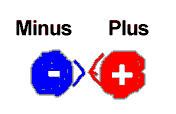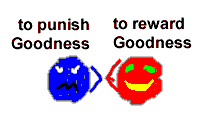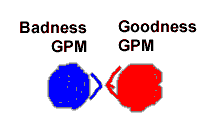|
The |
|
The |
R6-EW - What You Audit
The core of the Reactive Mind consists of
mental masses. There is a significance, an idea, attached to each of these
masses. The masses and ridges have physical substance and that is what you can measure
with an E-meterô. The masses and significances can cause all kinds of mental and physical
conditions in the PC. The masses can cause physiological conditions and illness of
severe nature. The significances attached can cause the strangest behavior in people and
make them perform and display this behavior out of the conviction that others ought to behave
just like them; or they simply have no awareness of that they are doing anything out of
the ordinary.
Strange and irrational behavior dictated by the Bank is what we call a dramatization. It is formally defined as: thinking or acting in a manner that is dictated by masses or significances contained in the reactive mind. When dramatizing, the individual is like an actor playing his dictated part and going through a whole series of irrational actions.
The whole purpose of auditing is to take these masses apart. At the level of R6-EW we for the first time get a glimpse of how these masses hold together and stay solid. It's like in physics where we gradually understand more about atoms, molecules, protons, electrons, and so on and the forces that keep all these particles together. Only, when we talk about the Reactive Mind we are not interested in tiny particles because our approach is not using physics and engineering to take it all apart. We don't use chemistry or medicine. We operate on the Axioms that have proven out in practice. These masses and their significances can be As-is-ed by the PC only when he gets an understanding of the mechanisms involved and view them exactly as is. We want to enable the PC to view the whole thing from the inside, from being in the middle of it. And we want the PC to be able to understand enough of the structure of it all in terms of the Time-track and his own experiences, his own decisions and postulates and so on to be able to handle this charge. Only by going this way will the PC be able to As-is the masses and ridges and make the significance in them powerless and thus handle them more permanently.
You may have the idea that the Time-track is a long linear record of pictures and experiences. Like a very long film strip stretched out on the ground from here and to the end of the world. That is a practical way to illustrate the Time-track and this analogy works very well when we talk incident running, Engram running and so on.
When we come to the core of all these black masses that make up the Bank it does however become clear, that 'in here' things are much more solid. It may look chaotic at first glimpse but a close inspection will reveal that everything is actually very orderly. We find the GPMs, the Goal-Problems-Masses. In each GPM we find opposites that hold each other in check. We find the Thetan's long range Goals; that's a significance. But each Goal was met by opposition and eventually abandoned. This conflict created a mass. The Goal and the opposition attracted each other and they repelled each other. It ended up in a draw and it ended up creating a permanent mass before it was abandoned. Then a new Goal was taken up and the story repeated itself. The Goals and the opposition became a solid mass with significance in it and left behind. The basis of any such conflict was Goal and opposition. The two sides became the poles in a battery; plus and minus.
 |
|
The structure of the
core Bank |
Atomic and molecular physics study the tiny particles that make up matter and make up all the different basic substances and compounds. Inside each atom we find positive and negative. We find particles with positive charge balanced against particles with negative charge. These forces are repeated in molecules, just on a bit lager scale. We find these plus and minus forces again in the matter made up by these molecules and when the mix consists of many different types of molecules. We end up with a "thing" without much thought of these internal forces that hold it together.
 |
|
A Pair inside the
'Goodness GPM'. |
When we talk GPMs we have a very similar thing at work. We have a positive Goal and a Negative Opposition Goal facing each other permanently. But one Pair attracts and sticks together with other Pairs in a complex manner. In one GPM we find a series of such Pairs. The Goals are very similar and the the Opposition Goals are fine-tuned to neutralize each other. This forms a zigzag pattern of similar conflicting ideas, the one modified slightly to the next.
When we go further we find the GPMs among themselves also hang together. We find one complete GPM hangs onto the next one and they form a line of railroad cars. When we are all the way through such a train of GPMs we will find the first Pair in the earliest GPM sticks to the last one in the latest GPM so the GPM super-structure seems to form a circle. There are many associations of criss-cross connections based on similarities and opposites of words and content as well.
The Goals and Items in a GPM actually have a position on the Time-track. One GPM is within a finite period of time. What all these Pairs in this GPM have in common is one End-word. An End-word is the noun (or a condition made into a noun) in a Goals statement. If we have a Goal 'to catch cats' the End-word is the noun 'Cats'. This means that all the Goals in that whole GPM have to do with 'Cats'. Goals in this fictive example could be: 'To catch cats', 'to feed cats', 'to love cats'. Opposed to these Goals could be: 'to let loose cats', 'To starve cats', 'To hate cats'; on and on about all the things that can be done or made up when it comes to cats and how each of them could be opposed. But the common denominator is 'Cats' and the "Cat GPM" in our example happened in a certain time period when our Thetan was all obsessed about cats.
R6-EW and Key-out
When it comes to the process called R6-EW we are simply knocking on
the door. We are still not in a position where we want to go into the thick of
all this. We go for Key-out of these core masses of the GPMs. We do not want to
know all there is to know about them at this point but simply be able to key
them out and rise above them, so to speak.
To accomplish this we find the hot End-words. Each GPM has just one End-word in common. That means each End-word we find is only going to restimulate a very finite part of the whole core structure or mass. We are not getting in over our heads.
 |
|
The GPMs among themselves
form |
If we were going for the Root-words (the verb in the Goal) such as 'Catch' we would restimulate many different GPMs. There would be one containing 'to catch cats', one 'to catch birds', one 'to catch fish' and so on, belonging to 'The Cat GPM', 'The Bird GPM' and 'The Fish GPM' respectively and we would have restimulated many different parts of the Time-track and of the core of the Bank and we would be in a lot of trouble.
So when it is called Routine 6 End-Words it is because the End-words are what we are interested in and what we find and finding them and finding opposites give us a tremendous look at this whole core structure of the Reactive Mind and its GPMs and we are capable of accomplishing high level Key-outs.
End-Words
As mentioned, what we are looking for are End-words, one EW at the time that read on the
Meter. You will find
broader concepts read better than specifics. If your first thought when looking
for an End-word is 'Cars' it may not read because it is too specific. If you broaden
the concept to 'Machinery' it very well may. For one thing 'Machinery' can be
found early on the Time-track while there are no 'Cars' there. Thus 'Cars' may
form a Lock close to present time but won't be an actual End-word from a GPM.
You will also find that a lot of the hot End-words may sound a little funny in normal language. You will find a lot of adjectives and verbs made into nouns. You will find that you should use endings like -ness, -ity, -ice, -ion and so on. This is how you grammatically can turn adjectives and verbs into nouns.
Examples: Adj: nice. Noun: nicety. Adj: good. Noun: goodness. Verb: Capture. Noun: Captivity. Verb: Reflect. Noun: Reflection.
You may first find an item or character you know from daily life and that is where you start. But the trick is to broaden it into a concept that could exist early on the Time-track and thus you get these somewhat odd sounding words, but they sure are hot in the Bank. Your first thought in finding an End-word may be 'Clown'. The one that actually reads with a Long Fall is however 'Assininities'. So you work with these first ideas and make sure you get something that would fit in and make sense early on the Time-track and especially what you find gives a good Meter read. You should expect to get a Long Fall or better on an End-word found in the Bank.
Dichotomies
We talked about Goals and Opposition Goals. In a similar manner we have End-words as plus and minus.
When we talk about Dichotomies in relation to GPMs we mean plus and minus. A plus word and a minus
word.
They are of the same order of things. They always belong to the same overall
group or subject. A crude example would be "A Pear" and "Pearlessness".
Thatís a Pair, a Dichotomy.
We could have "White" and "Black" form a Dichotomy. The
subject they have in common would be visibility or color.
Plus and minus form a current between them as you will find in an electrical
battery. We donít simply mean active/passive. For example, the active, such as
"Soldier" and the passive, such as "Civilian" do not form a Dichotomy.
We mean the bold PLUS and MINUS of something, two opposites of a major subject
or idea.
They are opposed to each other and interchange current. They are in conflict. What is generally agreed to be
the unwanted or poor side is minus. What is generally conceived to be all right
is plus.
On the subject of war the Minus to a soldier would be an activist pacifist - or possibly a
friendly soldier opposite an enemy soldier.
Other example: we have the major idea that an individual has a financial status.
Wealth is the PLUS and Poverty is the MINUS.
So a DICHOTOMY means two parts of a major idea. We have two opposites in active conflict with each other.
You can get dictionaries that give synonyms. They are usually called a thesaurus.
Some of them will also give antonyms, words with opposite meanings, such
as 'Good' and 'Bad'. You need to get such an antonym dictionary when doing R6-EW as Solo-auditing. Such a dictionary will help you when looking for answers to
the processes of R6-EW.
Handling Dramatizations
The gains the PC can expect from this kind of processing is the handling of
dramatizations. Each End-word taken up represents an awful lot of Bank and
reactivity. The PC tends to dramatize these End-words in life and behavior. The
trick, of course, is for the Solo-auditor to be so well audited previously so he now can look
at himself with a detached eye and see what is going on. Once he can see the
behavior, the dramatization, he can find the End-word behind that dramatization
by working with the
process and the Meter.
© Prometheus International, 2004. Plus fair use quotes from Ron Hubbard's published notes and works.